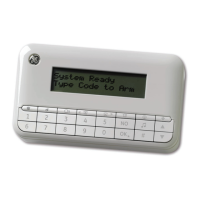NetworX Version 3 Installation Manual
177
3. Select Learn RF Device> Learn Siren/IO, and then select the new siren number (Siren/IO
1 to 4) and press OK.
4. Depending on the siren type, select Internal Siren or External Siren and press OK. The
panel starts the learning-in procedure, and the Learn-in Mode message is displayed on the
keypad(s).
5. Power-up the IO module in the siren with tamper open by connecting a battery pack or
inserting batteries (consult the siren's manual for details).
6. Wait until the LED on the IO module board blinks for 0.5 second.
7. Trip the siren's tamper switch, simulating the closing of the housing for at least 0.5
second and maximum of 5 seconds, and release the tamper again.
8. The LED on the IO module will blink for 1 second, and the keypad beeps once to confirm
the siren is programmed.
9. The siren is learned-in. Insert the batteries powering the siren, if necessary, and close the
siren housing.
Any new IO module is learned-in by default as a universal siren, i.e. its both outputs are triggered by
the Any Siren event. In order to program it as a burglary-only or a fire-only siren you have to select
appropriate triggering event (i.e. Burglary Siren or Fire Siren) under RF Receivers>RF Receiver
32>Outputs>I/O x Output y>Event.
Note: For a detailed description of the steps required to install the particular siren, see the siren's installation manual.
Note: You can delete a siren using the Del. RF Device menu option.
Configuring receiver features
Configurable receiver features include tampers and communication errors. The following example
enables RF jamming detection on RF receiver 32. RF communication is considered to be jammed
when there has been a jamming signal for more than 30 seconds in a 60 second window.
1. Navigate with the ½¾ keys to RF Receivers>RF Receiver 32>Receiver Features and
press OK.
2. Scroll to Jam Detection>Enabled and press OK.
3. The keypad beeps once to accept the change and returns to Jam Detection.
Configuring IO modules
The I/O module is a PCB-only device, which can be connected to any application, thus allowing the
application to be controlled through a wireless link. The application to be controlled must have a
power supply of its own. One important application for the I/O module is the wireless siren/beacon,
which has its own battery pack to operate on while using the I/O module for wireless control and
supervision (see
Installing the wireless sirens on page 33).
The I/O module and its batteries must be located inside the tamper-protected housing of the
application it controls and supervises. Opening of this housing is reported to the panel as a tamper
condition.

